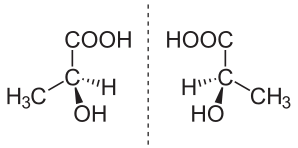There have been many reports on this forum re: concerns about the different potencies of brands of baclofen that we are all using. Houtx's recent post about a conversation with Dr. LeVin where he (LeVin) is suspect of the Indian baclofen Houtx is using has got me thinking a bit (I've also spoken to Dr. LeVin, and I have every reason to believe that he's legitimate and that his advice is sound). So here's some ideas from just a tiny bit of research:
I believe some Baclofen preparations can be racemic, i.e. a mixture of different enantiomers (mirror images of the same drug molecule that look the same, but can be effectively different).
from wikipedia:

(that's lactic acid)
Enantiomers of each other often show different chemical reactions with other substances that are also enantiomers. Since many molecules in the body of living beings are enantiomers themselves, there is often a marked difference in the effects of two enantiomers on living beings. In drugs, for example, the working substance is often one of two enantiomers, while the other one is responsible for adverse effects.
[...]
Another example are the antidepressant drugs Escitalopram (aka Lexapro) and Citalopram (aka Celexa). Citalopram is a racemate [1:1 mixture of (S)-Citalopram and (R)-Citalopram]; Escitalopram [(S)-Citalopram) is a pure enantiomer. The dosages for Escitalopram are typically 1/2 of those for Citalopram, and there are fewer side effects, suggesting that most side effects come from the (R)-enantiomer.
And here's a random medical journal article mentioning potency differences in r and s baclofen enantiomers: Stereoselectivity of spinal neurotransmission: Effects of baclofen enantiomers on tail-flick reflex in rats
Summary Spinal rats and rats with an intact neuraxis received an intrathecal injection of an enantiomer of baclofen. TheR-enantiomer was 100–1000 times more potent than its antipode in inhibiting the tail-flick reflex, both in intact rats and in spinal rats. Spinalization enhanced the inhibitory effects of both enantiomers without altering their dose-response relations. The findings show that baclofen enantiomers have direct actions on stereoselective spinal mechanisms and that spinalization fails to alter the stereoselectivity of spinal mechanisms towards the enantiomers.
Just food for thought. I'm not suggesting that any one company is making *deficient* preparations of baclofen, but each may be using a slightly different formulation that may or may not work in the same way as the next. Many, many folks on this forum are having success with generic baclofen made by companies from all over the world. Some reports on this forum confirm that suddenly switching or substituting other brands in their dosing can cause marked side effects. Baclofen is a generic drug whose patent has expired long ago, the patented information on how to manufacture it should be public. So I would expect that the easiest way for pharmaceutical companies to make baclofen would be to just follow that manufacturing blueprint. Generic drugs have to meet Bioequivalence standards to be certified for use in different countries. It may be more cost effective (or seem unimportant) to produce baclofen in different preparations (especially if bioequivalence is based on a lower dose-80mg max- than we are all taking). Just my 2 cents, and I hope that it's useful information. I think my best advice here is if you are going to switch among different brands of baclofen in your dosing, be sure to do it gradually (i.e 100% Brand A to 75% Brand A + 25% Brand B to 50% Brand A + 50% Brand B to 25% Brand A + 75% Brand B to 100% Brand B - you get the picture). -tk 165mg - equal dosing 8am,4pm,12am (which has really helped a lot) not there yet, but close, I think. Good luck everyone.

 There is much here that would ideally be looked at, but what hope have we when they won't even (as yet) properly research Bac's use for alcoholism?
There is much here that would ideally be looked at, but what hope have we when they won't even (as yet) properly research Bac's use for alcoholism?
Comment